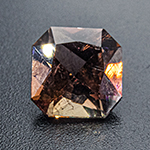Axinite
Name for a group of minerals of the silicates and germanates class. Group members are Axinite-Fe, Axinite-Mg, Axinite-Mn and Tinzenite. Most axinites are Axinite-Fe.

Axinit-Fe from the Nausherwani Mine, Karhan District, Balutchistan, Pakistan
Origin of name: originally named Espéce de Schorl by Johann Gottfried Schreiber in 1781. Named Schorl violet and Schorl transparent lenticulaire by Romé de L'Isle in 1785. Named Thumerstein by Abraham Gottlob Werner in 1788, later spelled Thumite. Named Yanolite by Jean Claude de la Métherie in 1792. Named Glasschörl by Blumenberg in 1799 (also glasstein). Named axinit in 1797 by Rene Just Haüy from the Greek αξίνα ("axina") for "axe", in allusion to the common habit of its crystals. Renamed ferroaxinite by Waldemar T. Schaller in 1909 for iron dominance in the formula. Renamed with suffix "-(Fe)" by IMA in 2007.
mindat.org
Synonyms and trade names: see above, origin of name
Can be confused with: similarly coloured minerals like andalusite, kornerupine, tourmaline, smoky quartz, topaz and others
Localities: worldwide, mindat.org lists about 800 localities, more than 40 in Austria
Handling: axinite is quite hard but rather brittle and cleaves well in one direction. heat-sensitive, unset before soldering.
Axinite shop
Gemmological Properties of Axinite
Ca2MgAl2BSi4O15OH
Ca2Mn2+Al2BSi4O15(OH)
Ca2Mn2+4Al4[B2Si8O30](OH)2
 Deutsch
Deutsch